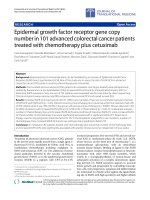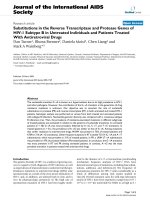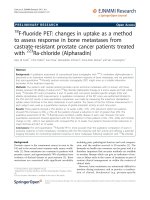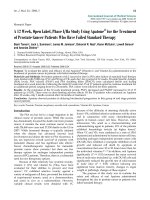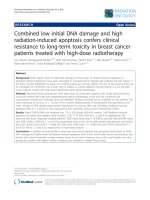The outcome of prostate cancer patients treated with curative intent strongly depends on survival after metastatic progression
Bạn đang xem bản rút gọn của tài liệu. Xem và tải ngay bản đầy đủ của tài liệu tại đây (889.07 KB, 8 trang )
Pascale et al. BMC Cancer (2017) 17:651
DOI 10.1186/s12885-017-3617-6
RESEARCH ARTICLE
Open Access
The outcome of prostate cancer patients
treated with curative intent strongly
depends on survival after metastatic
progression
Mariarosa Pascale1, Che Ngwa Azinwi2, Barbara Marongiu1, Gianfranco Pesce2, Flavio Stoffel3
and Enrico Roggero1*
Abstract
Background: Five-year survival in patients with localized prostate cancer (PCa) is nearly 100%, but metastatic disease
still remains incurable. Clinical management of metastatic patients has become increasingly complex as novel
therapeutic strategies have emerged. This study aims at evaluating the impact of the first metastatic progression on
the outcome of PCa patients treated with curative intent.
Methods: The analysis was conducted using data of 913 cases of localized PCa diagnosed between 2000 and 2014.
All patients were treated with curative surgery (N = 382) or radiotherapy (N = 531) with or without adjuvant therapy.
All metastases were radiologically documented. The prognostic impact of the first site of metastasis on metastasis-free
survival (MFS) and PCa-specific survival (PCaSS) was investigated by univariate and multivariate analyses.
Results: One hundred and thirty-six (14.9%) patients developed a metastatic hormone-sensitive PCa and had a median
PCaSS of 50.4 months after first metastatic progression. Bone (N = 50, 36.8%) and LN or locoregional (N = 52, 38.2%)
metastases occurred more frequently with a median PCaSS of 39.7 and 137 months respectively (p < 0.0001). Seven
patients developed visceral metastasis only (5.1%; liver, lung, brain) and 27 (19.9%) concurrent metastases; this last
group was associated with the worst survival with a median value of only 17 months. Thus, each subgroup exhibited a
survival after metastasis significantly different from each other. In multivariate analysis the site of the first metastasis was
an independent prognostic factor for PCaSS along with Gleason score at diagnosis. The correlation between survival
and first site of metastasis was confirmed separately for each therapy subgroup. Median metastasis-free survival from
primary diagnosis to first metastasis was not correlated with the first site of metastasis.
Conclusions: In non-metastatic PCa patients treated with curative intent, the PCa-specific survival time depends on
the time after metastatic progression rather than the time from diagnosis to metastasis. Moreover, the site of first
metastasis is an independent prognostic factor for PCaSS. Our data confirm that the first metastatic event may confer a
differential prognostic impact and may help in identifying patient at high risk of death supporting the treatmentdecision making process following metastatic progression.
Keywords: Prostate cancer, Metastasis, Prognosis, Curative intent, Radiotherapy, Radical prostatectomy
* Correspondence:
1
Medical oncology Unit, Oncology Institute of Southern Switzerland (IOSI),
6500 Bellinzona, Switzerland
Full list of author information is available at the end of the article
© The Author(s). 2017 Open Access This article is distributed under the terms of the Creative Commons Attribution 4.0
International License ( which permits unrestricted use, distribution, and
reproduction in any medium, provided you give appropriate credit to the original author(s) and the source, provide a link to
the Creative Commons license, and indicate if changes were made. The Creative Commons Public Domain Dedication waiver
( applies to the data made available in this article, unless otherwise stated.
Pascale et al. BMC Cancer (2017) 17:651
Background
Prostate cancer (PCa) is the most frequent tumor in
men and a major leading cause of cancer-related deaths
in developed countries [1]. Many men have tumors that
grow very slowly, whereas others develop very aggressive
disease, which metastasizes rapidly spreading to elsewhere in the body. The majority of patients with localized PCa will be cured after local therapy with five-year
survival near 100% [2]; but once the tumor progresses
developing distant metastasis, the disease often become
incurable [2, 3]. Indeed advanced prostate cancer still accounts for the majority of the mortality from this disease
[4, 5], although survival might be extensive [6]. The
most common metastatic sites are bone and lymph
nodes (LN) [4, 7–14], but visceral metastases may also
be present [4, 5, 7, 8, 10–14] and may be associated with
a more severe clinical course [5, 8, 12, 13, 15–17].
In the last years several studies have suggested the
prognostic importance of the site of metastasis in men
with de novo metastatic PCa [8, 11] or metastatic
castration-resistant prostate cancer (mCRPC) [5, 13]. To
our knowledge, few studies [9, 12, 14, 18] have assessed
the impact of location of metastatic disease on the outcome of men with PCa after receiving curative treatment. Shao et al. [18] firstly demonstrated that primary
treatment may make a difference with regard to survival
time after metastasis; both Nini et al. [12] and Moschini
et al. [14] found that nodal and local recurrence have a
more favorable prognosis compared with skeletal and
visceral metastases in pN+ patients treated with radical
prostatectomy. Local and nodal site were the most frequent primary location of metastasis in patients treated
with both radiotherapy [9] and prostatectomy [12, 14].
In this work we sought to address this issue by using a
cohort of non-metastatic primary PCa patients who
underwent prostatectomy or radiotherapy with curative
intent with the aim of evaluating the impact of the first
metastatic event on PCa-specific survival in order to respond to the need to improve the treatment-decision
making process following metastatic progression.
Page 2 of 8
considered. Some patients received adjuvant therapy
after prostatectomy (N = 87; 22.8%), including hormonal
therapy (N = 25) or radiation therapy (N = 40) or both
(N = 22). Most of patients treated with radiotherapy received a concomitant hormonal treatment (N = 432;
81.3%) (Fig. 1). First-line therapy was chosen according
to standard clinical practice.
Definitions of metastasis subgroups
Patients developing a metastatic hormone-sensitive disease, defined as a tumor responding to hormone therapy,
were categorized into one of the following subgroups according to the site of the first metastatic progression of
the disease after curative treatment: 1) presence of exclusive bone metastasis (Bone-only subgroup); 2) presence of
LN or locoregional metastasis, alone or concomitant
(Locoregional/LN-only subgroup); 3) presence of exclusive
visceral disease (Visceral-only subgroup) and 4) presence
of multiple sites of metastasis (Multiple site subgroup).
Visceral disease was defined as metastatic disease to liver,
lung, brain and other organ sites. Patients with multiple
metastatic sites were further stratified in one of the following categories: a) patients with bone metastasis with LN
or locoregional disease and b) patients with visceral disease with bone, nodal or locoregional involvement. All
metastases were radiologically documented (MRI or CT
scan or Choline-PET scan or bone scintigraphy). Followup visits and imaging examinations were performed
according to standard clinical practice or in case of symptomatic disease.
Outcomes
Study endpoints were: PCa-specific survival (PCaSS), defined as the time interval from the date of primary PCa
diagnosis to the date of PCa related-death or last followup; metastasis-free survival (MFS), defined as the time
interval from the date of primary PCa diagnosis to the
first radiographic metastasis; PCa-specific survival after
metastasis (PCaSS after metastasis), defined as the time
interval from the date of the first radiographic metastasis
to the date of PCa related-death or last follow-up.
Methods
Patients
Statistical analysis
An observational analysis was performed by using a
database of 1364 patients diagnosed with PCa from 2000
to 2014 at Oncology Institute of Southern Switzerland
(IOSI) and Urology Unit of San Giovanni Hospital
(OSG). Clinical, pathological, and demographic data
were registered. Agreement was obtained from the Ethics Committee of Canton Ticino to collect and analyze
data without disclosing patient identifiers. Follow-up
data were collected through August 2015.
Radical prostatectomy (N = 382) and external beam
radiation therapy (N = 531) with curative intent were
Demographic characteristics of patients were reported
using median and interquartile ranges for continuous
variables and frequencies and proportions for categorical
variables. The independent t test and the chi-square test
were used to assess associations between continuous
and categorical variables, respectively.
Estimates of medians, rate and 95% confidence intervals
(CIs) were determined using the Kaplan–Meier method.
Patients were censored if they were still alive or they were
lost to follow-up. Differences in survival times were
evaluated using the log-rank test. A multivariable Cox
Pascale et al. BMC Cancer (2017) 17:651
Page 3 of 8
Fig. 1 Cohort selection for non-metastatic primary PCa patients treated with curative intent
regression analysis was used to assess the prognostic impact of the first site of metastasis on PCaSS and MFS after
adjusting for other covariates that might partially influence the outcome. All variables associated with univariate
value of p ≤ 0.05 were included in the multivariate model.
All tests were considered statistically significant at
p ≤ 0.05. Statistical analyses were carried out using software STATA software (StataCorp. 2011. Stata Statistical
Software: Release 12. College Station, TX: StataCorp LP).
Results
Patients
Of the 1364 men with PCa registered in our database,
913 patients with localized disease who underwent curative treatment were identified. Histologically all of them
were acinar adenocarcinoma of the prostate. In particular, 382 patients underwent radical prostatectomy, without (N = 295) or with adjuvant radiation (N = 40) or
hormonal (N = 25) therapy or both (N = 22), and 531
men were treated with external beam radiation treatment (N = 531), without (N = 99) or with hormonal
therapy (N = 432). Median age at diagnosis of the entire
cohort was 67 years (IQR 62.7–71.8). After a median
follow-up of 5.7 years (IQR 2.9–8.8) from the date of
primary tumor diagnosis, 60 patients (6.6%) have died.
Five-year PCaSS rate was 97.2% (95% CI 95.6–98.2). Of
913 patients, 136 (14.9%) developed a metastatic
hormone-sensitive PCa.
Disease characteristics of the cohort according to the
development of the metastatic disease and curative treatment are summarized in Tables 1 and 2, respectively. Patients who progressed to metastasis had a lower age at
diagnosis (median value 65.3 vs 67.2 years old), higher
PSA, elevated Gleason Score and more LN involvement
than patients who did not progress (Table 1). As expected,
patients treated with prostatectomy were younger (median
value 63.4 vs 70.3 years old) and had different disease
characteristics compared with patients who underwent
radiotherapy (Table 2). But no significant statistically differences between the two treatment modalities were found
according to the site of metastasis at first progression of
the disease after curative treatment (p = 0.158).
Metastases at first progression
Distribution of metastatic sites at first progression
At the time of first progression, metastases were most
often to LN and/or locoregional area (N = 52, 38.2%)
and to bone (N = 50, 36.8%). The remaining patients
Pascale et al. BMC Cancer (2017) 17:651
Page 4 of 8
Table 1 Clinical-pathological characteristics of 913 primary PCa
patients by first metastatic progression
Table 2 Clinical-pathological characteristics of 913 primary PCa
patients by curative intent treatment
Parameter
at diagnosis
First line therapy
No recist
progression
N (%)
First recist
progression
N (%)
S/S + other
N (%)
RT/RT + HO
N (%)
P-value
< 50
6 (0.8)
2 (1.5)
< 50
6 (1.6)
2 (0.4)
< 0.001*
≥ 50 and <60
106 (13.6)
29 (21.3)
≥ 50 and <60
107 (28)
28 (5.3)
≥ 60 and <75
266 (69.6)
≥ 60 and <75
570 (73.4)
401 (75.5)
97 (71.3)
≥ 75 and <80
≥ 75 and <80
2 (0.5)
86 (16.2)
80 (10.3)
8 (5.9)
≥ 80
1 (0.3)
≥ 80
14 (2.6)
15 (1.9)
0
T1-T2
191 (50.1)
360 (68.2)
T1
175 (22.6)
12 (9)
T3
186 (48.8)
156 (29.5)
T2
337 (43.5)
27 (20.1)
T4
4 (1.1)
12 (2.3)
T3
254 (32.8)
88 (65.7)
1
3
T4
9 (1.1)
7 (5.2)
2
2
N0
322 (85.2)
514 (98.3)
N1
56 (14.8)
9 (1.7)
4
8
P-value
Age (years)
Age (years)
0.036*
Stage
Stage
Missing
< 0.001*
Missing
Lymph nodes
Lymph nodes
Negative
725 (94.4)
111 (83.5)
Positive
43 (5.6)
22 (16.5)
9
3
Missing
< 0.001*
329 (43.6)
40 (38.5)
≥ 10 and <20
282 (37.3)
28 (26.9)
> 20
144 (19.1)
36 (34.6)
22
32
3–6
238 (32)
18 (16.8)
7
326 (43.8)
37 (34.6)
8–10
180 (24.2)
52 (48.6)
Missing
33
29
Total (N)
777
136
Missing
Missing
< 0.001*
PSA (ng/ml)
PSA (ng/ml)
< 10
< 0.001*
0.001*
< 10
189 (56.4)
180 (34.3)
10–20
101 (30.2)
209 (39.9)
≥ 20
45 (13.4)
135 (25.8)
47
7
3–6
79 (22.1)
177 (35.9)
7
192 (53.6)
171 (34.7)
8–10
87 (24.3)
145 (29.4)
24
38
Missing
< 0.001*
Gleason Score
Gleason Score
< 0.001*
*Significant value
developed visceral-only disease (N = 7, 5.1%) or metastases involving multiple sites (N = 27, 19.8%; of which
N = 16, 11.8% bone metastasis with LN or locoregional
disease and N = 11, 8.1% visceral disease with bone, nodal
or locoregional involvement). Visceral disease involved
liver (N = 3), lung (N = 11), liver and lung (N = 2), liver
and brain (N = 1), other (N = 1). Therapy after diagnosis
of metastasis is reported in Additional file 1: Table S1.
Missing
< 0.001*
First metastatic event
Bone-only
30 (40.54)
20 (32.26)
Loco/LN-only
28 (37.4)
24 (38.71)
Visceral-only
1 (1.35)
6 (9.68)
Multiple site
15 (20.27)
12 (19.35)
382
531
Total (N)
0.158
S Surgery, RT Radiotherapy, HO Hormonal therapy; other: adjuvant therapy.
*Significant value
compared with the Bone-only and the Multiple site subgroups (96.1%, 95%CI: 85.2–99.0; 84.2%, 95%CI: 69.7–
92.2; 64.0%, 95%CI: 42.0–79.5 respectively; p = 0.0126)
(Additional file 3: Figure S2).
PCa-specific survival
Five-year PCaSS rate were 100% and 85% (95% CI 77.5–
90.2) for patients who did not develop and who developed metastasis, respectively (Additional file 2: Figure
S1). When patients were stratified according to the first
site of metastasis, the Locoregional/LN-only subgroup
had significantly higher 5-year PCaSS survival rate
Metastasis-free survival
Median MFS was 49.6 months (95% CI 39.1–60.1) with
estimated 5- and 10-year MFS of 41.9% (95% CI 33.6–
50.0) and 13.2% (95% CI 8.2–19.5), respectively. No statistically significant differences were revealed in MFS
according to metastasis subgroups (Fig. 2a; p = 0.6088).
Pascale et al. BMC Cancer (2017) 17:651
Page 5 of 8
Fig. 2 Survival curves by first metastatic event of 136 PCa patients progressing after curative treatment of primary tumor. a Metastasis-free survival
curves (b) PCa-specific survival curves. p-value from log-rank test is reported. Numbers of at risk (still alive) patients are indicated below the x-axis
MFS was also analyzed according to curative therapy subgroups and neither radical prostatectomy nor radiotherapy
showed statistically significant differences in MFS according to metastasis subgroups (Additional file 4: Figure S3;
p = 0.4649 for radical prostatectomy and p = 0.8222 for
radiotherapy). Multivariable Cox regression analysis for
MFS was not statistically significant (p = 0.4795).
PCa-specific survival after first metastasis
3.2.4.1.Overall analysis Median PCaSS after metastasis
was 50.4 months (95% CI 39.1–78.5). After stratifying
patients according to the first metastatic site, median
PCaSS after metastasis were 39.7 months (95% CI 32.9–
51) for the Bone-only subgroup, 137 months (95% CI
65.3–nr) for the Locoregional/LN-only subgroup and
17 months (95% CI 8.9–33.8) for the Multiple site subgroup (p < 0.001) (Fig. 2b). For this last subgroup, the
presence of visceral metastases worsened the prognosis
by 3 months (18.1 vs 15.1). Median PCaSS after metastasis for the Visceral-only subgroup was not reached.
3.2.4.2.Analysis by therapy groups To further investigate the impact of the site of the metastatic disease on
the outcome, additional analysis was performed after
stratifying patients according to the therapy subgroup.
Overall median PCaSS after metastasis were 57.4 months
(95% CI 39.1–113.1) and 42.9 months (95% CI 27.2–nr)
for patients treated with surgery and radiation therapy,
respectively (p = 0.5928). In the prostatectomy subgroup,
median PCaSS after metastasis were 46.1 months (95%
CI 33.3–113.1) for men with bone-only metastases,
78.5 months (95% CI 57.4–nr) for men with Locoregional/LN-only metastases and 18.1 months (95% CI 6.1–
nr) for men with multiple locations of the metastastic
disease (p = 0.0004; Fig. 3a). Whereas PCaSS after metastasis in the radiotherapy subgroup were 32.9 months
(95% CI 18.4–65.4) and 15.07 (95% CI 6–nr) for men
with bone-only metastases and multiple metastatic sites,
respectively; men with Locoregional/LN metastasis did
not reach median survival (p = 0.0006) (Fig. 3b). None
of subgroups of metastasis showed statistically significant differences between the two curative treatments
(Logrank test, p = 0.2054 for Bone-only, p = 0.6158 for
Locoregional/LN-only, p = 0.6321 for Multiple site).
Multivariate analysis predicting PCa-specific survival
Multivariable Cox regression analysis showed that the first
site of metastasis is an independent predictor of PCaSS
(Table 3). Particularly, patients who progressed to boneonly and to multiple sites had a higher risk of dying from
PCa compared with those developing Locoregional/LNonly disease with HR of 3.88 (p = 0.011) and 3.56, respectively (p = 0.019). Moreover, Gleason score was the
only primary tumor parameter that represented an independent predictor of PCaSS. Patients with Gleason score
8–10 had a worst PCaSS compared with those having
lower grade cancer (HR 2.45, p = 0.020).
Discussion
In this data set analysis of men receiving curative radiotherapy or surgery for primary PCa, the site of the first
metastasis was an independent prognostic factor for PCa
Pascale et al. BMC Cancer (2017) 17:651
Page 6 of 8
Fig. 3 PCa-specific survival curves by first metastatic event of 136 PCa patients progressing after curative treatment of primary tumor. a Radical
prostatectomy subgroup. b Radiotherapy subgroup. p-value from log-rank test is reported. Numbers of at risk (still alive) patients are indicated
below the x-axis
death. In the entire cohort, men initially developing LN
or locoregional metastases, which were the most frequent along with bone in our series as already reported
by other authors [4, 9, 12, 14], had the best survival
followed by those with osseous metastases. Men having
metastases at multiple locations exhibited the worst
prognosis; moreover, a shorter survival was associated
with disease involving visceral sites too. These data are
consistent with other authors who showed that multiple
recurrences had a poorer prognosis than a single recurrence in pN+ patients treated with radical prostatectomy
[14] and a worse outcome in presence of visceral involvement in newly metastatic patients [8, 10]. This
Table 3 Multivariate analysis of prognostic factors based on
Cox proportional hazards regression model in 136 primary PCa
patients progressing to metastatic hormone-sensitive disease
after curative treatment
Variable
Hazard ratio
95% CI
p-value
Age at diagnosis (years)
1.05
0.97–1.13
0.213
PSA (ng/ml)
10–20 vs < 10
0.31
0.09–1.13
0.076
> 20 vs < 10
1.47
0.66–3.29
0.348
0.82
0.31–2.38
0.687
2.47
1.15–5.29
0.020*
1.37–10.98
0.011*
Stage
T3-T4 vs T1-T2
Gleason Score
> 7 vs ≤ 7
Site of metastasis at first progression
Bone-only vs Loco/LN-only
3.88
Visceral-only vs Loco/LN-only
1.89
0.20–18.10
0.582
Multiple site vs Loco/LN-only
3.56
1.24–10.24
0.019*
CI Confidence interval; * significant value
trend in PCaSS was confirmed when the analysis was
done separately for curative surgery or radiotherapy. The
Locoregional/LN-only subgroup had the best prognosis
in both therapy subgroups confirming previous findings
in pN+ patients treated with radical prostatectomy [12,
14]. Therefore, our study highlights that PCa-specific
survival strongly depends on the time after metastasis.
In fact, median survival from primary diagnosis to initial
metastasis (MFS) was independent of the site of the first
metastatic event; indeed, each metastatic subgroup
exhibited a very similar MFS with a median value of
49.6 months, very alike to that found by Ost et al. [9] in
patients treated with radiotherapy. This result was
confirmed also for each therapy subgroup, separately.
Our findings could be explained by the expression of
different biologic characteristics that underlie the spread
of PCa cells to metastatic sites. Indeed, it seems that
tumor cells that spread only to LNs may have acquired
specific phenotypic modifications that predispose to the
preferential invasion of lymphatic vessels and access to
lymph nodes [10, 12, 20, 19]. These cells might acquire
the ability to spread from lymph nodes to distant organs
via blood or lymphatic channels only after subsequent
neoplastic transformations [3, 12, 20, 21]. Thus, PCa
cells that disseminate to nodes harbor a less aggressive
phenotype compared with those spreading systemically
to other sites. This may explain the more favorable prognosis of patients with local/nodal recurrence compared
with those with systemic disease, as already suggested by
others [12]. On the other hand, visceral disease seems to
be a very adverse prognostic factor, especially in de novo
metastatic PCa [8] and mCRPC patients [5, 13, 15, 17].
However, it was reported as having a favorable outcome
in the absence of extensive bone metastases [16] and in
Pascale et al. BMC Cancer (2017) 17:651
metastatic patients at initial diagnosis [10, 11, 22]. Interestingly, Pouessel et al. [22] analyzing patients with localized or locally advanced disease at diagnosis found
that median overall survival was 6 months for patients
who had a late diagnosis of liver metastasis and
14 months for whom liver was part of the initial pattern
of metastases. This finding was consistent with Wang et
al. [23] that showed that the outcome of liver metastasis
was worse for patients whose liver metastasis was synchronous at primary PCa diagnosis than in those for
whom the liver was a site of progressive PCa. In our
series men having visceral-only disease were underrepresented and it was impossible to make a definitive
conclusion on the outcome of those patients; however,
we found that the presence of visceral disease worsened
the outcome of men having other metastases, as previously shown by others [8, 10]. Of note, Gleason score
was the only baseline parameter predicting PCaSS endorsing its prognostic value for disease-specific survival
[24] and further reinforcing that poorly differentiated
cancers tend to have a more aggressive biological behavior, including high risk of metastasis [25].
Finally, the prevalence of metastasis to specific sites,
mostly to bone and nodal/locoregional area [4, 9, 12,
14], has been explained biologically by the interaction
between metastatic tumor cells and the organ microenvironment [26], favored by a preferential homing [27],
or purely by the anatomy of vascular and lymphatic
drainage from the site of the primary tumor [28].
Our work is certainly limited by its observational design and institutional registry-based study; thus, nonstandardized timing for imaging, changes in treatment
indication and imaging over years, inherent biases in the
institution and other confounders may have been affected the results. On the other hand, being a singlecenter study it has allowed us to analyze a homogeneous
curative cohort of non-metastatic PCa managed by
standard local protocol and to demonstrate the prognostic role of the location of the metastatic hormonesensitive disease independently in both intervention
groups. Moreover, our data clarify that the time after
metastatic progression rather than the time from diagnosis to metastasis strongly impacts on patients’ outcome and above all that the first metastatic event is an
important factor in defining the prognosis of patients
treated with curative intent and it will help in the
treatment-decision making process following metastatic
progression. Further studies addressing this topic are imperative to find additional parameter to stratify men with
PCa into prognostic groups according to their metastatic
disease. Moreover, studies investigating the biologic
mechanisms underlying metastatic spread to specific locations are also needed. All these data might have important implications for the development of novel
Page 7 of 8
therapeutic approaches targeting the specific metastatic
site that will help in selecting the optimal therapy for individual patients according to the metastatic disease they
will experience.
Conclusions
In PCa patients initially treated with curative intent, the
PCa-specific survival strongly depends on the time after
metastatic progression and the first location of metastasis. Thus, metastatic site may confer a differential prognostic impact and may be used to identify patients at
the highest risk of death. Our results provide the
conceptual framework for treating patients according
to the metastatic disease and advance arguments to
introduce location of metastasis as a research parameter in PCa studies.
Additional files
Additional file 1:Table S1. Therapy after diagnosis of the first metastasis.
Summary of therapies that patients received after the diagnosis of a metastasis.
(DOCX 35 kb)
Additional file 2: Figure S1. PCa-specific survival curves. (A) Entire
cohort of 913 non-metastatic primary PCa patients treated with curative
intent. (B) Survival curves by first metastatic event. p-value from log-rank
test is reported. Numbers of at risk (still alive) patients are indicated
below the x-axis. (TIF 5180 kb)
Additional file 3: Figure S2. PCa-specific survival curves by first
metastatic event of 136 PCa patients progressing after curative treatment of
primary tumor. p-value from log-rank test is reported. Numbers of at risk (still
alive) patients are indicated below the x-axis. (TIF 5704 kb)
Additional file 4: Figure S3. Metastasis-free survival curves by first
metastatic event of 136 PCa patients progressing after curative treatment
of primary tumor. (A) Radical prostatectomy subgroup. (B) Radiotherapy
subgroup. p-value from log-rank test is reported. Numbers of at risk (still
alive) patients are indicated below the x-axis. (TIF 5390 kb)
Abbreviations
CI: Confidence Interval; GS: Gleason score; IQR: Interquartile range; LN: Lymph
node; mCRCP: Metastatic castration-resistant prostate cancer;
MFS: Metastasis-free Survival; PCa: Prostate Cancer; PCaSS: PCa-specific
Survival; PSA: Prostatic Specific Antigen
Acknowledgements
Not applicable.
Funding
This study was partially supported by grants from ABREOC and Fondazione
ticinese per la ricerca sul cancro. The founding bodies provided support for
data collection; they did not play any role in study design, analysis and
interpretation of data nor in the writing of the manuscript.
Availability of data and materials
The dataset analyzed during the current study available from the corresponding
author on reasonable request. Individual patient data cannot be made available.
Authors’ contributions
MP and ER contributed to data analysis and interpretation. BM was involved
in data collection. MP and ER drafted the manuscript. All authors were
involved in the critical revision of the manuscript. All authors contributed
and approved the final version of this manuscript.
Pascale et al. BMC Cancer (2017) 17:651
Ethics approval and consent to participate
Agreement was obtained from the Ethics Committee of Canton Ticino to
collect and analyze data without disclosing patient identifiers. The data were
used without informed consent according to articles 37–39 of the Ordinance
on Human research and article 34 of the Swiss law on human research.
Consent for publication
Not applicable.
Competing interests
The authors declare that they have no competing interests.
Page 8 of 8
14.
15.
16.
Publisher’s Note
Springer Nature remains neutral with regard to jurisdictional claims in published
maps and institutional affiliations.
Author details
1
Medical oncology Unit, Oncology Institute of Southern Switzerland (IOSI),
6500 Bellinzona, Switzerland. 2Radiation oncology unit, Oncology Institute of
Southern Switzerland (IOSI), 6500 Bellinzona / 6900 Lugano, Switzerland.
3
Urology unit, Ospedale San Giovanni, 6500 Bellinzona, Switzerland.
17.
18.
Received: 10 November 2016 Accepted: 28 August 2017
References
1. Torre LA, Bray F, Siegel RL, Ferlay J, Lortet-Tieulent J, Jemal A. Global cancer
statistics, 2012. CA Cancer J Clin. 2015;65:87–108.
2. DeSantis CE, Lin CC, Mariotto AB, Siegel RL, Stein KD, Kramer JL, Alteri R,
Robbins AS, Jemal A. Cancer treatment and survivorship statistics, 2014. CA
Cancer J Clin. 2014;64:252–71.
3. Arya M, Bott SR, Shergill IS, Ahmed HU, Williamson M, Patel HR. The
metastatic cascade in prostate cancer. Surg Oncol. 2006;15:117–28.
4. Antonarakis ES, Feng Z, Trock BJ, Humphreys EB, Carducci MA, Partin AW,
Walsh PC, Eisenberger MA. The natural history of metastatic progression in
men with prostate-specific antigen recurrence after radical prostatectomy:
long-term follow-up. BJU Int. 2012;109:32–9.
5. Pond GR, Sonpavde G, de Wit R, Eisenberger MA, Tannock IF, Armstrong AJ.
The prognostic importance of metastatic site in men with metastatic
castration-resistant prostate cancer. Eur Urol. 2014;65:3–6.
6. Freedland SJ, Humphreys EB, Mangold LA, Eisenberger M, Dorey FJ, Walsh
PC, Partin AW. Risk of prostate cancer-specific mortality following
biochemical recurrence after radical prostatectomy. JAMA. 2005;294:433–9.
7. Gandaglia G, Abdollah F, Schiffmann J, Trudeau V, Shariat SF, Kim SP,
Perrotte P, Montorsi F, Briganti A, Trinh Q, Karakiewicz PI, Sun M.
Distribution of metastatic sites in patients with prostate cancer: a
population-based analysis. Prostate. 2014;74:210–6.
8. Gandaglia G, Karakiewicz PI, Briganti A, Passoni NM, Schiffmann J, Trudeau V,
Graefen M, Montorsi F, Sun M. Impact of the site of metastases on survival
in patients with metastatic prostate cancer. Eur Urol. 2015;68:325–34.
9. Ost P, Decaestecker K, Lambert B, Fonteyne V, Delrue L, Lumen N, Ameye F,
De Meerleer G. Prognostic factors influencing prostate cancer-specific
survival in non-castrate patients with metastatic prostate cancer. Prostate.
2014;74:297–305.
10. James ND, Spears MR, Clarke NW, Dearnaley DP, De Bono JS, Gale J,
Hetherington J, Hoskin PJ, Jones RJ, Laing R, Lester JF, McLaren D, Parker
CC, Parmar MKB, Ritchie AWS, Russel JM, Strebel RT, Thalmann GN, Mason
MD, Sydes MR. Survival with newly diagnosed metastatic prostate cancer in
the “Docetaxel era”: data from 917 patients in the control arm of the
STAMPEDE trial (MRC PR08, CRUK/06/019). Eur Urol. 2015;67:1028–38.
11. Koo KC, Park SU, Kim KH, Rha KH, Hong SJ, Yang SC, Chung BH. Prognostic
impacts of metastatic site and pain on progression to castrate resistance
and mortality in patients with metastatic prostate cancer. Yonsei Med J.
2015;56:1206–12.
12. Nini A, Gandaglia G, Fossati N, Suardi N, Cucchiara V, Dell’Oglio P,
Cazzaniga W, Luzzago S, Montorsi F, Briganti A. Patterns of clinical
recurrence of node-positive prostate cancer and impact on long-term
survival. Eur Urol. 2015;68:777–84.
13. Halabi S, Kelly WK, Ma H, Zhou H, Solomon NC, Fizazi K, Tangen CM,
Rosenthal M, Petrylak DP, Hussain M, Vogelzang NJ, Thompson IM, Chi KN,
de Bono J, Armstrong AJ, Eisenberger MA, Fandi A, Li S, Araujo JC,
19.
20.
21.
22.
23.
24.
25.
26.
27.
28.
Logothetis CJ, Quinn DI, Morris MJ, Higano CS, Tannock IF, Small EJ. Metaanalysis evaluating the impact of site of metastasis on overall survival in
men with castration-resistant prostate cancer. J Clin Oncol. 2016;34:1652–9.
Moschini M, Sharma V, Zattoni F, Quevedo JF, Davis BJ, Kwon E, Karnes RJ.
Natural history of clinical recurrence patterns of lymph node-positive
prostate cancer after radical prostatectomy. Eur Urol. 2016;69:135–42.
Goodman OBJ, Flaig TW, Molina A, Mulders PF, Fizazi K, Suttmann H, Li J,
Kheoh T, de Bono JS, Scher HI. Exploratory analysis of the visceral disease
subgroup in a phase III study of abiraterone acetate in metastatic castrationresistant prostate cancer. Prostate Cancer Prostatic Dis. 2014;17:34–9.
Pezaro CJ, Omlin A, Lorente D, Nava Rodrigues D, Ferraldeschi R, Bianchini
D, Mukherji D, Riisnaes R, Altavilla A, Crespo M, Tunariu N, de Bono JS,
Attard G. Visceral disease in castration-resistant prostate cancer. Eur Urol.
2014;65:270–3.
Evans CP, Higano CS, Keane T, Andriole G, Saad F, Iversen P, Miller K, Kim
CS, Kimura G, Armstrong AJ, Sternberg CN, Loriot Y, de Bono J, Noonberg
SB, Mansbach H, Bhattacharya S, Perabo F, Beer TM, Tombal B. The PREVAIL
study: primary outcomes by site and extent of baseline disease for
Enzalutamide-treated men with chemotherapy-naive metastatic castrationresistant prostate cancer. Eur Urol. 2016;70:675–83.
Shao Y-HJ, Kim S, Moore DF, Shih W, Lin Y, Stein M, Kim IY, Lu-Yao GL.
Cancer-specific survival after metastasis following primary radical
prostatectomy compared with radiation therapy in prostate cancer patients:
results of a population-based, propensity score-matched analysis. Eur Urol.
2014;65:693–700.
Barekati Z, Radpour R, Lu Q, Bitzer J, Zheng H, Toniolo P, Lenner P, Zhong
XY. Methylation signature of lymph node metastases in breast cancer
patients. BMC Cancer. 2012;12:244.
Briganti A, Passoni NM, Abdollah F, Nini A, Montorsi F, Karnes RJ. Treatment
of lymph node-positive prostate cancer: teaching old dogmas new tricks.
Eur Urol. 2014;65:26–8.
Gundem G, Van Loo P, Kremeyer B, Alexandrov LB, Tubio JM,
Papaemmanuil E, Brewer DS, Kallio HM, Högnäs G, Annala M, Kivinummi K,
Goody V, Latimer C, O'Meara S, Dawson KJ, Isaacs W, Emmert-Buck MR,
Nykter M, Foster C, Kote-Jarai Z, Easton D, Whitaker HC, Prostate ICGC, UK
Group, Neal DE, Cooper CS, Eeles RA, Visakorpi T, Campbell PJ, McDermott
U, Wedge DC, Bova GS. The evolutionary history of lethal metastatic
prostate cancer. Nature. 2015;520:353–7.
Pouessel D, Gallet B, Bibeau F, Avancès C, Iborra F, Sénesse P, Culine S. Liver
metastases in prostate carcinoma: clinical characteristics and outcome. BJU
Int. 2007;99:807–11.
Wang H, Li B, Zhang P, Yao Y, Chang J. Clinical characteristics and
prognostic factors of prostate cancer with liver metastases. Tumour Biol.
2014;35:595–601.
Egevad L, Granfors T, Karlberg L, Bergh A, Stattin P. Prognostic value of the
Gleason score in prostate cancer. BJU Int. 2002;89:538–42.
Stamey TA, McNeal JE, Yemoto CM, Sigal BM, Johnstone IM. Biological
determinants of cancer progression in men with prostate cancer. JAMA.
1999;281:1395–400.
Paget S. The distribution of secondary growths in cancer of the breast.
1889. Cancer Metastasis Rev. 1989;8:98–101.
Jacob K, Webber M, Benayahu D, Kleinman HK. Osteonectin promotes
prostate cancer cell migration and invasion: a possible mechanism for
metastasis to bone. Cancer Res. 1999;59:4453–7.
Ewing J. Neoplastic diseases: a treatise on Tumours. Third ed. Philadelphia
and London: W. B. Saunders Co. Ltd.; 1928.
Submit your next manuscript to BioMed Central
and we will help you at every step:
• We accept pre-submission inquiries
• Our selector tool helps you to find the most relevant journal
• We provide round the clock customer support
• Convenient online submission
• Thorough peer review
• Inclusion in PubMed and all major indexing services
• Maximum visibility for your research
Submit your manuscript at
www.biomedcentral.com/submit


